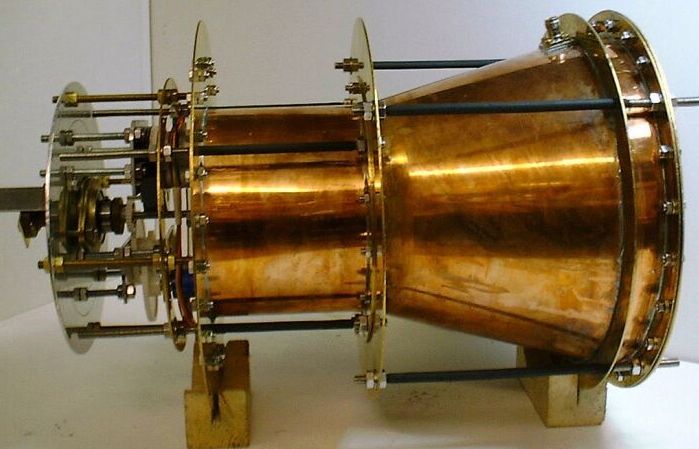Ever since NASA announced that they had created a prototype of the controversial
Radio Frequency Resonant Cavity Thruster
(aka. the EM Drive), any and all reported results have been the subject of controversy. Initially, any reported tests were the stuff of rumors and leaks, the results were treated with understandable skepticism. Even after the paper submitted by the Eagleworks team
passed peer review
, there have still been unanswered questions.
Hoping to address this, a team of physicists from TU Dresden - known as the SpaceDrive Project - recently conducted an
independent test
of the EM Drive. Their findings were presented at the
2018 Aeronautics and Astronautics Association of France's Space Propulsion
conference, and were less than encouraging. What they found, in a nutshell, was that much of the EM's thrust could attributable to outside factors.
The results of their test were reported in a study titled "
The SpaceDrive Project - First Results on EMDrive and Mach-Effect Thrusters
", which recently appeared online. The study was led by Martin Tajmar, an engineer from the Institute of Aerospace Engineering at TU Dresden, and included TU Dresden scientists Matthias Kößling, Marcel Weikert and Maxime Monette.
[caption id="attachment_139288" align="aligncenter" width="580"]
EMDrive Thruster: Cavity (Left), Antenna (Middle) and On Balance (Right). Credit: Martin Tajmar, et al.
[/caption]
To recap, the EM Drive is a concept for an experimental space engine that came to the attention of the space community years ago. It consists of a hollow cone made of copper or other materials that reflects microwaves between opposite walls of the cavity in order to generate thrust. Unfortunately, this drive system is based on principles that violate the
Conservation of Momentum
law.
This law states that within a system, the amount of momentum remains constant and is neither created nor destroyed, but only changes through the action of forces. Since the EM Drive involves electromagnetic microwave cavities converting electrical energy directly into thrust, it has no reaction mass. It is therefore "impossible", as far as conventional physics go.
As a result, many scientists have been skeptical about the EM Drive and wanted to see definitive evidence that it works. In response, a team of scientists at NASA's Eagleworks Laboratories began conducting a test of the propulsion system. The team was led by Harold White, the Advanced Propulsion Team Lead for the NASA Engineering Directorate and the Principal Investigator for NASA's Eagleworks lab.
Despite a report that was leaked in November of 2016 - titled "
Measurement of Impulsive Thrust from a Closed Radio Frequency Cavity in Vacuum
" - the team never presented any official findings. This prompted the team led by Martin Tajmar to conduct their own test, using an engine that was built based on the same specifications as those used by the Eagleworks team.
[caption id="attachment_128906" align="aligncenter" width="580"]
According to tests conducting by a team from TU Dresden, the EM Drive's thrust may be the result of interaction with Earth's magnetic field. Credit: ESA/ATG medialab
[/caption]
In short, the TU Dresden team's prototype consisted of a cone-shaped hollow engine set inside a highly shielded vacuum chamber, which they then fired microwaves at. While they found that the EM Drive did experience thrust, the detectable thrust may not have been coming from the engine itself. Essentially, the thruster exhibited the same amount of force regardless of which direction it was pointing.
This suggested that the thrust was originating from another source, which they believe could be the result of interaction between engine cables and the Earth's magnetic field. As they conclude in their report:
In other words, the mystery thrust reported by previous experiments may have been nothing more than an error. If true, it would explain how the "impossible EM Drive" was able to achieve small amounts of measurable thrust when the laws of physics claim it shouldn't be. However, the team also emphasized that more testing will be needed before the EM Drive can be dismissed or validated with confidence.
[caption id="attachment_115424" align="aligncenter" width="580"]
What will it take before human beings can travel to the nearest star system within their own lifetimes? Credit: Shigemi Numazawa/ Project Daedalus[/caption]
Alas, it seems that the promise of being able to travel to the
Moon in just four hours
, to
Mars in 70 days
, and to
Pluto in 18 months
- all without the need for propellant - may have to wait. But rest assured, many other experimental technologies are being tested that could one day allow us to travel within our Solar System (and beyond) in record time. And additional tests will be needed before the EM Drive can be written off as just another pipe dream.
The team also conducted their own test of the Mach-Effect Thruster, another concept that is considered to be unlikely by many scientists. The team reported more favorable results with this concept, though they indicated that more research is needed here as well before anything can be conclusively said. You can learn more about the team's test results for both engines by reading their
report here
.
And be sure to check out this video by Scott Manley, who explains the latest test and its results
Further Reading: ResearchGate
,
 Universe Today
Universe Today
